This site is supported by our readers. We may earn a commission, at no cost to you, if you purchase through links.

For bacterial infections, you’ll likely need vet-prescribed antibiotics. Fungal issues? Antifungal meds and a dry, clean enclosure work wonders.
If mites are the problem, grab a reptile-safe treatment and clean every nook of their habitat—think of it as spring cleaning, snake edition.
Always keep humidity and temperature levels just right, as improper conditions often spark skin troubles. Regularly check your snake’s shedding for signs of stuck skin or irregularities.
A little prevention can save a lot of slithery stress down the line!
Table Of Contents
- Key Takeaways
- Snake Skin Infections
- Diagnosing Skin Issues
- Treating Snake Skin Problems
- Preventing Skin Infections
- Managing Snake Skin Health
- Frequently Asked Questions (FAQs)
- How do you manage snake disease?
- How do you treat snake fungal disease?
- What to do if a snake has blisters?
- How to take care of a pet snake?
- Do snakes have skin problems?
- How to treat snake skin infection?
- What is the best way to cure a snake skin?
- What to put on snake skin?
- What are the primary causes of snake abscesses?
- How can constipation lead to snake skin issues?
- Conclusion
Key Takeaways
- Keep your snake’s habitat clean, monitor humidity and temperature, and ensure proper ventilation to prevent skin issues.
- Spot and treat infections early with reptile-safe antifungal, antibacterial, or mite treatments recommended by a vet.
- Quarantine new snakes and inspect their skin regularly to avoid spreading parasites or diseases.
- Watch for warning signs like unusual shedding, skin lesions, or behavioral changes, and act quickly with professional care if needed.
Snake Skin Infections
You’ll notice something’s wrong with your snake’s skin when bacterial, fungal, or parasite infections cause visible lesions, unusual shedding, or changes in texture and color.
Early detection and proper treatment of these infections can prevent serious complications and help your reptile friend heal faster.
Bacterial Dermatitis
Many snake owners encounter bacterial dermatitis at some point, often called "scale rot."
It’s typically caused by poor husbandry, skin trauma, or mite infestations.
Look for red, inflamed skin with blister-like lesions and raised scales.
Diagnosis requires microbial cultures and environmental assessment.
Treatment combines antibiotic therapy (mindful of antibiotic resistance), wound management, and correcting habitat issues.
Different species show varying susceptibility, so consult a reptile vet promptly to address bacterial dermatitis.
Fungal Infections
Fungal infections in snakes can creep up without warning, particularly Snake Fungal Disease caused by Ophidiomyces ophiodiicola.
You’ll need to act quickly when you spot scabs or crusty skin lesions.
- Apply topical antifungals to treat localized infections
- Consider systemic treatment with medications like Terbinafine
- Adjust environmental factors by reducing humidity
- Provide thermal and nutritional support during recovery
- Monitor disease impact through regular veterinary checks
Mite Infestations
While fungal issues affect snake skin surfaces, mite infestations present a different challenge altogether.
These tiny parasites can wreak havoc on your snake’s health if left untreated.
Identifying snake mites early is essential—look for small black bugs on white paper or hiding under scales, and watch for unusual behavior in your reptile.
One key preventative measure is following a detailed quarantine procedure for new snakes.
| Infestation Symptoms | Treatment Options | Preventative Measures |
|---|---|---|
| Excessive soaking | Vegetable oil bath | Quarantine new snakes |
| Rubbing on surfaces | Provent-A-Mite spray | Regular enclosure inspection |
| Visible black dots | Water flosser rinse | Paper towel substrate |
| Lethargy/appetite loss | Veterinary medications | Habitat deep cleaning |
The symptoms of a mite infestation can be excessive soaking, rubbing on surfaces, visible black dots, and lethargy/appetite loss.
Treatment options include Vegetable oil bath, Provent-A-Mite spray, Water flosser rinse, and Veterinary medications.
Preventative measures such as quarantine new snakes, Regular enclosure inspection, Paper towel substrate, and Habitat deep cleaning can help prevent infestations.
Environmental Factors
While eliminating mites requires direct treatment, your snake’s environment often causes skin problems in the first place.
Eliminating mites is crucial, but a clean and well-maintained environment is the first defense against snake skin problems.
Poor habitat conditions are like sending an invitation to infections.
Your enclosure setup directly impacts your snake’s skin health.
- Incorrect humidity levels can lead to stuck sheds and scale rot
- Inappropriate substrate choice often harbors bacteria and fungi
- Poor ventilation creates condensation that promotes skin infections
- Improper temperature regulation weakens your snake’s immune response
Diagnosing Skin Issues
You’ll need to recognize the warning signs of skin problems in your snake before they worsen, including unusual scales, discoloration, or irregular shedding patterns.
Early identification through visual inspection and professional testing can make the difference between simple treatment and serious complications, which is crucial for the snake’s health and requires early action.
Clinical Signs
Now that you’ve identified possible skin infections in your snake, recognizing clinical signs early can save your pet from serious complications.
Watch for skin lesions or scale abnormalities, which often appear as raised, crusty patches.
Early symptoms include unusual shedding issues, where skin doesn’t come off in one piece, and behavioral changes like reduced activity or appetite frequently accompany these problems.
Eye abnormalities such as cloudy eyes may signal deeper issues, and these snake skin disease symptoms typically worsen without proper intervention.
Laboratory Diagnosis
In the process of confirming snake skin issues, laboratory diagnosis provides the definitive answers you need.
Getting accurate results requires proper testing methods and quick action.
Here’s how vets confirm skin infections in snakes:
- Culture methods to grow and identify fungal or bacterial pathogens
- PCR testing to detect fungal DNA in skin samples
- Laboratory confirmation through fluid analysis from blisters
- Specialized testing at veterinary diagnostic labs with reptile expertise
For a thorough evaluation, vets might also perform histopathological examinations to get a thorough evaluation and accurate results.
Histopathology
While laboratory tests provide valuable insights, histopathology offers a deeper look at what’s happening beneath the scales.
This tissue analysis method reveals cellular abnormalities invisible to the naked eye.
| Histopathology Feature | What It Tells You |
|---|---|
| Scale cell integrity | Infection severity |
| Inflammatory markers | Immune response |
| Fungal elements | Ophidiomyces presence |
| Bacterial colonies | Secondary infections |
| Tissue architecture | Chronic vs. acute condition |
Your vet will need skin biopsies for this microscopic examination, which remains the gold standard for definitive disease identification, providing a clear understanding of the immune response.
Diagnostic Accuracy
Diagnostic accuracy in snake skin problems hinges on a combination of timing and technique.
You’ll get the most reliable results when veterinary expertise meets proper sample collection.
Early detection substantially improves treatment outcomes.
- The sinking feeling when a misdiagnosis leads to ineffective treatment
- The relief when accurate testing confirms what you’ve suspected
- The frustration of inconclusive results from poor sample quality
- The confidence that comes with definitive laboratory confirmation methods
Treating Snake Skin Problems
You’ll find effective treatment for your snake’s skin issues by combining appropriate medications with proper environmental adjustments.
From antifungal treatments for fungal infections to antibiotics for bacterial problems, addressing both the symptoms and underlying causes guarantees your scaly friend returns to peak health.
Antifungal Medications
Now that you’ve confirmed a fungal infection, you’ll need effective antifungal medications to combat snake fungal disease (SFD). Recent research shows promising results with several options.
| Medication | Administration | Effective Levels |
|---|---|---|
| Terbinafine | Nebulization (2mg/ml) | Requires 3+ treatments |
For minor infections, try topical applications like povidone-iodine. For venomous species, terbinafine nebulization offers a safer, hands-off approach with good efficacy.
Antibiotic Therapy
When treating bacterial infections in your snake, antibiotic therapy requires precision.
For most snake skin problems, vets recommend piperacillin/tazobactam or ciprofloxacin.
Dosage guidelines vary by species—ball pythons need 10mg/kg of azithromycin every 3-7 days, while treatment duration typically spans at least one month.
Monitor for antibiotic resistance by scheduling follow-ups, and consider probiotics to support recovery during long-term therapy.
Surgical Intervention
When severe skin infections don’t respond to medication alone, surgical intervention becomes necessary.
Your veterinarian may perform lesion removal or abscess drainage using specialized debridement techniques for infected tissue. Scale reconstruction might be needed for extensive damage.
Surgical procedures include careful wound closure and occasionally skin grafting for larger defects. These advanced wound care methods are most effective when performed by reptile specialists, reducing amputation risks in critical cases.
Regular skin inspections help detect early problems, which is a key aspect of effective treatment.
Supportive Care
While surgical procedures address severe lesions, your snake’s recovery depends heavily on proper supportive care.
You’ll need to provide thermal support by maintaining ideal temperature gradients, ensuring your snake can thermoregulate effectively.
Fluid therapy prevents dehydration, while nutritional support helps strengthen their immune response.
Regular wound management using gentle debridement techniques removes dead tissue.
Don’t underestimate stress reduction—a quiet recovery space dramatically improves healing outcomes.
Preventing Skin Infections
You’ll save yourself countless hours of stress and expensive vet bills by implementing proper infection prevention strategies for your scaly friend.
Maintaining clean enclosures, quarantining new snakes, and conducting regular health checks will create a protective barrier against common skin infections that can quickly escalate into serious health concerns.
Quarantine Procedures
When isolating a snake, a proper quarantine setup is your first line of defense.
Keep the snake in a separate, clean enclosure for at least a three-month isolation duration.
Regularly monitor behavior and skin for issues, reducing stress during quarantine helps prevent spread and supports healing.
Optimal environmental conditions are essential during this time, stick to strict biosecurity and monitoring protocols to safeguard other reptiles.
Habitat Maintenance
Keeping your snake’s home clean is no small task, but it’s key to their health.
Regular enclosure disinfection prevents bacteria buildup. Substrate management means scooping waste and replacing soiled sections.
Monitor humidity and temperature with a hygrometer and thermometer.
A proper temperature gradient keeps them comfortable, while ventilation needs guarantee fresh air.
Clean water quality also boosts habitat hygiene.
Biosecurity Measures
When managing snake habitats, focus on biosecurity measures like enforcing strict quarantine protocols for new arrivals and practicing proper infection control.
Habitat disinfection minimizes risks, while safe handling reduces disease spread.
Regular disease surveillance guarantees early problem detection.
Prioritize enclosure hygiene by cleaning surfaces thoroughly and disposing of waste promptly, which supports robust disease prevention and fosters a healthier ecosystem through effective disinfection protocols.
Public Awareness
Public awareness is key to tackling snake skin problems.
Educate yourself and others about SFD through community outreach and conservation efforts. Encourage responsible ownership by sharing tips on snake skin care.
Report sightings of affected snakes to aid research.
Snake enthusiasts and caretakers can amplify SFD education by hosting workshops, fostering conversations, and connecting with local wildlife organizations to promote SFD education.
Managing Snake Skin Health
Proper habitat setup and care play a big role in keeping your snake’s skin healthy.
By managing humidity, substrate, and lighting, you can prevent common issues from turning into serious problems.
Habitat Setup
A healthy snake environment starts with thoughtful habitat setup.
- Pick an enclosure size that allows movement yet feels secure.
- Maintain a temperature gradient for proper thermoregulation.
- Monitor humidity levels to prevent snake skin problems like shedding issues.
- Add hiding spots—snakes love privacy, and stress-free snakes are healthier snakes.
Selecting the correct snake tank size is essential for their well-being. Your snake’s habitat is its sanctuary, so create it wisely to ensure a healthy snake.
Substrate Options
A well-kept snake habitat starts with the right substrate. Your choice affects substrate hygiene, burrowing needs, and humidity levels.
Natural substrates like coconut fiber or cypress mulch help with humidity retention, while paper towels are cost-effective. Selecting the correct material can be simplified by researching various substrate options.
Evaluate your snake’s skin needs carefully with this table:
| Substrate | Pros | Cons | Maintenance | Cost |
|---|---|---|---|---|
| Coconut Fiber | Retains humidity | Can clog heat pits | Spot clean often | Moderate |
| Cypress Mulch | Holds moisture, natural | May contain contaminants | Soak, bake to clean | Moderate |
| Aspen Shavings | Affordable, lightweight | Poor for moisture control | Replace regularly | Low |
| Paper Towels | Sterile, easy to replace | Doesn’t retain moisture well | Replace frequently | Low |
| Jungle Mix | Moisture rich, soft | Overwatering causes rot | Spot clean weekly | Moderate |
This information will help you make an informed decision about the best substrate for your snake, considering factors like moisture control and maintenance.
Humidity Control
Your snake’s shedding success relies on proper humidity levels.
Too dry, and you’ll face snake shedding problems like dysecdysis.
Use a hygrometer to monitor levels that align with species needs.
A snake hygrometer is essential for maintaining correct humidity.
Enclosure design matters—consider tight spaces for moisture retention.
Keep humidity balanced for respiratory health and address snake skin problems early.
Environmental control guarantees a smooth, stress-free shed.
Heating and Lighting Considerations
When setting up snake heating and lighting, think of it as a temperature tango.
Provide a temperature gradient with basking spots for warmth and cooler zones for relief.
Use safe heat sources and UVB lighting sparingly, ensuring UVB lighting safety.
Thermostat control prevents overheating.
Improper lighting types can stress snakes, so stick to their needs to keep them thriving with UVB lighting safety.
Frequently Asked Questions (FAQs)
How do you manage snake disease?
Imagine juggling flaming swords blindfolded—that’s the stress of managing snake diseases.
Watch for signs like lesions or odd behavior, keep habitats spotless, isolate the sick, and partner with a vet for proper treatment and care to ensure the health of your snakes.
How do you treat snake fungal disease?
Treating snake fungal disease involves antifungal medications like voriconazole, topical treatments for skin lesions, and supportive care like fluids and proper nutrition.
Quarantine infected snakes to prevent spread, and make certain their habitat stays clean and dry, which is a crucial part of supportive care.
What to do if a snake has blisters?
If your snake has blisters, clean the area gently with warm water and a reptile-safe antiseptic.
Improve habitat hygiene, especially humidity. If blisters worsen or show infection, consult an exotic vet for proper treatment.
How to take care of a pet snake?
Maintain moisture, manage meals, and monitor health!
Provide a clean enclosure with proper humidity, temperature, and bedding.
Feed appropriately, avoid live prey, and watch for shedding issues.
Regular check-ups guarantee a slithery, stress-free companion with proper care.
Do snakes have skin problems?
Yes, snakes can get skin problems like blisters, mites, and abscesses.
These often stem from poor habitat conditions, parasites, or infections.
Regular cleaning and monitoring can help you keep your snake’s skin healthy.
How to treat snake skin infection?
Use antifungal or antibacterial treatments depending on the cause, monitor symptoms closely, and make certain the snake’s habitat is clean with proper humidity.
If unsure, consult a vet—better safe than sorry with your slithery friend!
What is the best way to cure a snake skin?
Clean your snake’s habitat thoroughly, make certain proper humidity levels, and apply vet-recommended topical medications to affected areas.
If symptoms persist or worsen, seek a reptile vet’s advice to prevent complications.
Healthy environment equals healthier skin, and by following these steps, you can help ensure your snake has a healthy environment.
What to put on snake skin?
Apply a reptile-safe ointment, like chlorhexidine or silver sulfadiazine, to affected areas.
Avoid petroleum-based products as they can harm the skin.
Focus on treating specific issues and maintain a clean, well-regulated habitat for recovery.
What are the primary causes of snake abscesses?
Think of abscesses like unwelcome houseguests—they sneak in through bites, cuts, or scratches, often worsened by dirty habitats or poor hygiene.
Bacteria invades these wounds, creating painful pockets of infection beneath your snake’s skin, which can be considered unwelcome.
How can constipation lead to snake skin issues?
Constipation in snakes can cause bloating, increasing pressure on their skin.
This stress may lead to stretched, weakened skin or even sores.
Keeping hydration and proper diet in check helps avoid these uncomfortable issues.
Conclusion
Taking care of your snake’s skin might feel like handling a scaly superhero’s wardrobe, but treating common snake skin problems doesn’t have to be complex.
By identifying issues like infections, mites, or unsuitable conditions early, you’ll prevent bigger headaches later.
Keep their habitat clean, temperature steady, and humidity just right.
Always monitor shedding for irregularities, and with the right care and prevention, your snake will stay healthy and happy, ensuring fewer slithery surprises down the line, which is crucial for their overall well-being.
- https://medlineplus.gov/genetics/condition/harlequin-ichthyosis/
- https://snaketypes.com/snake-health-matters-common-issues-and-how-to-address-them/
- https://www.usgs.gov/centers/nwhc/science/snake-fungal-disease
- https://www.britannica.com/animal/coral-snake
- https://cwhl.vet.cornell.edu/disease/snake-fungal-disease

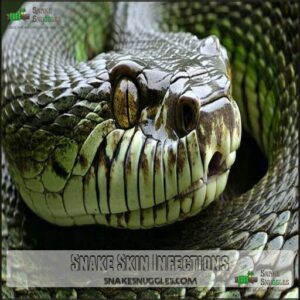

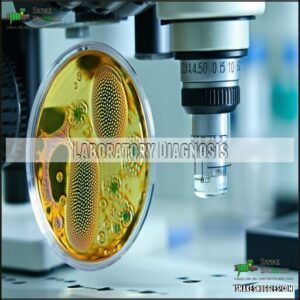

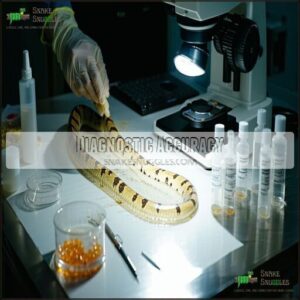
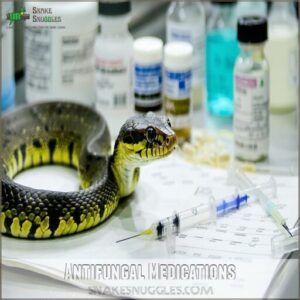
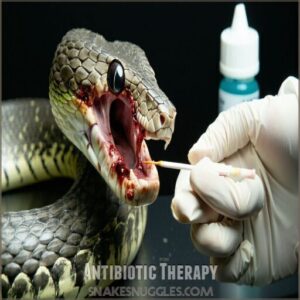










Kevin Quinn
October 4, 2025 at 11:19 AM
My lucistic ratsnake has mouth rot and some bad scales